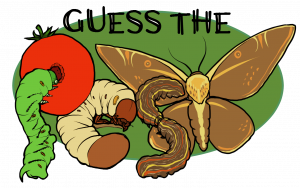
Bill Cissel, Extension Agent – Integrated Pest Management, University of Delaware; bcissel@udel.edu
Congratulations to John Swaine, III for correctly identifying the moths as true armyworms and for being selected to be entered into the end of season raffle for $100 not once but five times. Everyone else who guessed correctly will also have their name entered into the raffle. Click on the Guess the Pest logo to participate in this week’s Guess the Pest challenge!
Guess the Pest Week #6 Answers: True Armyworm
By Bill Cissel, Extension Agent, IPM and David Owens, Extension Entomologist

The correct answer to this past week’s Guess the Pest is True Armyworm (TAW). Adult TAW moths do not cause any direct injury to small grains; however, they can be seen in your fields making sure there is another generation. True armyworm (TAW) larvae damage small grains by clipping flag leaves and small grain heads. It is important to be able to accurately identify true armyworms because there is another “worm” that is also considered a pest of small grains, the grass sawfly. The grass sawfly is in the Order Hymenoptera, meaning it is more closely related to bees and wasps than moths, which are in the Order Lepidoptera. Even though grass sawflies cause similar damage to small grains, management differs between these two species of insects.
There are several reasons why it is important to be able to distinguish between grass sawflies and true armyworms:
1) Grass sawflies are more damaging than true armyworms because they prefer to feed on small grain stems as opposed to true armyworms that typically will feed on leaves before clipping heads. Also, grass sawfly damage usually occurs before the peak of armyworm damage.
2) The threshold for grass sawflies (wheat and barley – 0.4 linear ft of row) is lower than the threshold for true armyworms (barley – 1 per linear ft of row/ wheat-1- 2 –per linear ft of row).
3) Not all products that are labeled for true armyworm control will provide control of grass sawflies.
4) Insecticide rates also differ between the two species for some products.
There are several features that can be used to distinguish grass sawflies from true armyworm.
Grass sawflies larvae are active during the day and can often be found on the plants so “shaking” plants to dislodge larvae is necessary when sampling. They can be identified by their green color, large amber head, and 5-7 pairs of fleshy prolegs legs. Counting the number of prolegs is the most reliable way to determine if the “worm” is a grass sawfly or true armyworm.

Grass Sawfly Larva
True armyworms are active at night and can often be found curled around the base of plants or under crop residue during the day. Larvae have four pairs of fleshy abdominal prolegs not including the pair of legs at the very end of the abdomen. There also appears to be a large gap between the 3 pairs of true legs and the start of the fleshy prolegs.

True Armyworm Larva
If your field is at threshold for grass sawflies or armyworms, there are several things to keep in when selecting which product to apply. Is the insecticide labeled for the correct pest, i.e. if you have grass sawflies, make sure you are using a product labeled for grass sawfly control? What is the days to harvest restriction (this varies among products)? Is the insecticide labeled for the crop (not all products are labeled for all small grains)?
Here is a link with sampling guidelines, thresholds, and insecticide recommendations for true armyworm and grass sawfly: http://extension.udel.edu/ag/insect-management/small-grains/












